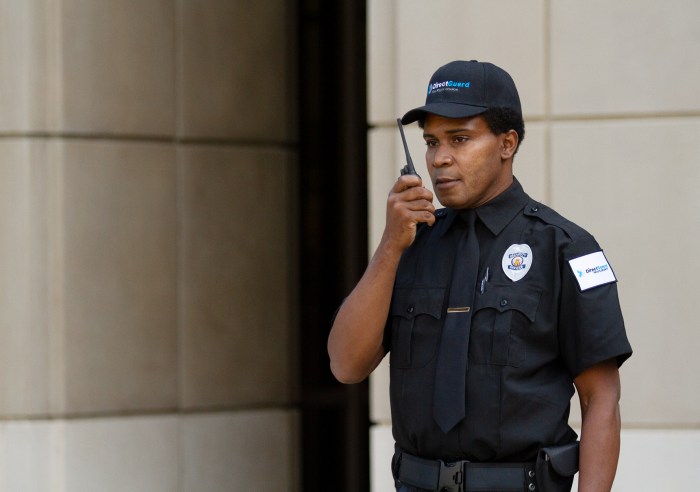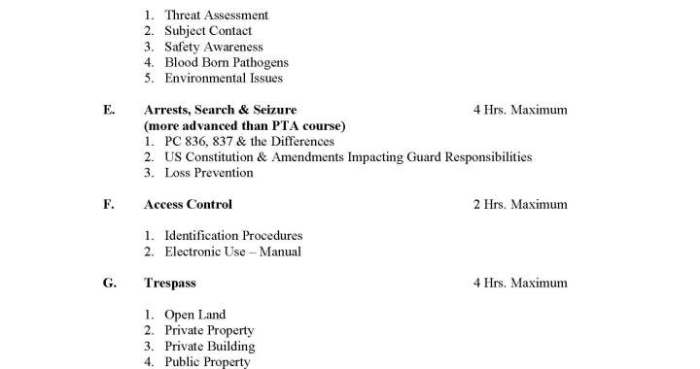The Unarmed Security Guard Practice Test: A Comprehensive Guide to Preparation and Success introduces readers to the intricacies of unarmed security guard training and certification, providing a comprehensive overview of the essential knowledge, skills, and strategies required to excel in this critical field.
This guide delves into the responsibilities, legal considerations, observation and reporting techniques, conflict management principles, emergency response procedures, and practice test structure, equipping aspiring security guards with the foundational understanding necessary for effective performance.
Unarmed Security Guard Responsibilities

Unarmed security guards are responsible for providing a safe and secure environment for their clients. They perform a variety of tasks, including:
Monitoring and Surveillance
- Patrolling assigned areas on foot or by vehicle
- Observing and reporting any suspicious activity or persons
- Monitoring security cameras and other surveillance equipment
Access Control
- Checking identification and credentials
- Granting or denying access to restricted areas
- Escorting visitors and employees
Emergency Response
- Responding to alarms and emergencies
- Providing first aid and CPR
- Evacuating buildings and assisting with crowd control
Customer Service
- Providing information and assistance to clients
- Answering questions and resolving concerns
- Maintaining a positive and professional demeanor
Physical and Mental Requirements
Unarmed security guards must possess a combination of physical and mental attributes to effectively perform their duties. They must be physically fit, with sufficient strength, agility, and endurance to handle various situations. Mentally, they should be alert, observant, and able to make quick decisions under pressure.
Physical Requirements
Physical fitness tests or assessments are often part of the hiring process for unarmed security guards. These tests may include:
- Push-ups: To assess upper body strength and endurance.
- Sit-ups: To assess core strength and endurance.
- Running: To assess cardiovascular fitness and endurance.
- Agility drills: To assess coordination, balance, and speed.
Mental Requirements
Mental attributes are equally important for unarmed security guards. They must be able to:
- Remain calm and collected under pressure.
- Make quick decisions and react appropriately to changing situations.
- Observe their surroundings and identify potential threats.
- Communicate effectively with colleagues and the public.
- Maintain a professional and courteous demeanor at all times.
Legal Considerations
Unarmed security guards have a legal authority and limitations that define the scope of their responsibilities and actions. It is crucial for them to understand and adhere to these legal boundaries to ensure their actions are within the parameters of the law.
Authority of Unarmed Security Guards
The authority of unarmed security guards is generally derived from the authority of the property owner or manager they are employed by. This authority allows them to take reasonable steps to protect the property, maintain order, and enforce rules and regulations within the premises.
Limitations of Unarmed Security Guards
While unarmed security guards have certain authorities, they also have limitations in their actions. They are not law enforcement officers and do not possess the same powers of arrest or use of force. Their primary role is to observe, report, and deter criminal activity, and they must act within the bounds of the law.
Importance of Understanding Local Laws and Regulations
It is essential for unarmed security guards to have a thorough understanding of local laws and regulations that govern their role. These laws and regulations vary by jurisdiction and may include guidelines on the use of force, trespassing, and reporting procedures.
By understanding these laws, guards can ensure their actions are compliant and avoid potential legal liabilities.
Observation and Reporting Skills

Unarmed security guards require keen observation and reporting skills to ensure the safety and security of their assigned areas. These skills involve detecting suspicious behavior, gathering accurate information, and effectively communicating observations to relevant authorities.
Detecting Suspicious Behavior
- Paying attention to body language:Observing gestures, facial expressions, and movements can indicate nervousness, anxiety, or intent.
- Monitoring patterns and deviations:Identifying unusual or inconsistent behaviors compared to established norms can signal potential threats.
- Scanning the environment:Regularly observing surroundings for any anomalies, such as unattended items, damaged property, or individuals loitering.
Gathering Accurate Information
- Maintaining situational awareness:Paying attention to the surroundings and keeping track of events and individuals present.
- Interviewing witnesses:Obtaining accounts from individuals who may have observed suspicious activity or possess relevant information.
- Documenting observations:Recording detailed notes, including time, location, physical descriptions, and any unusual behavior witnessed.
Communicating Observations
- Using clear and concise language:Relaying information in a manner that is easily understood and free of jargon.
- Providing timely reports:Promptly reporting suspicious activity or incidents to supervisors or law enforcement as appropriate.
- Collaborating with other guards:Sharing observations and information with colleagues to enhance situational awareness and response capabilities.
Conflict Management and De-escalation
Conflict management and de-escalation are essential skills for unarmed security guards, enabling them to handle confrontational situations safely and effectively without resorting to force.
Unarmed security guards should prioritize de-escalation by understanding the principles of conflict management, employing effective communication techniques, and implementing strategies to reduce tension and prevent confrontations from escalating.
Principles of Conflict Management
- Remain calm and composed: Maintain a professional demeanor and avoid escalating the situation.
- Listen actively: Pay attention to both verbal and non-verbal cues to understand the underlying causes of the conflict.
- Identify the root cause: Determine the core issues driving the conflict to address them effectively.
- Empathize and validate: Acknowledge the other person’s perspective, even if you don’t agree with it.
- Set clear boundaries: Establish limits and expectations while maintaining a respectful tone.
Communication Techniques
- Use clear and concise language: Communicate in a way that is easily understood and avoids ambiguity.
- Maintain eye contact: Establish a connection and demonstrate that you are engaged in the conversation.
- Use active listening: Repeat and paraphrase to show that you are understanding the other person’s perspective.
- Avoid confrontational language: Use “I” statements and focus on the behavior, not the person.
De-escalation Strategies
- Separate the parties: If possible, physically separate the individuals involved in the conflict to reduce tension.
- Provide space: Allow the individuals involved time to calm down and regain composure.
- Offer a solution: Suggest a mutually acceptable solution that addresses the underlying cause of the conflict.
- Involve a third party: If necessary, seek assistance from a supervisor or law enforcement to mediate the situation.
Emergency Response Procedures

Unarmed security guards must be well-versed in emergency response procedures to ensure the safety of individuals and property during critical situations. These procedures Artikel the steps that guards should take in the event of an emergency, including coordinating with law enforcement and other emergency services.
Coordinating with law enforcement and other emergency services is crucial for an effective response. Security guards should establish clear communication channels and protocols to ensure timely and efficient coordination. This involves maintaining regular contact with local law enforcement agencies, fire departments, and medical services, as well as developing contingency plans for various emergency scenarios.
Evacuation Procedures
- Security guards should be familiar with evacuation routes and procedures for the premises they are responsible for.
- They should assist in guiding occupants to safe areas and ensure that everyone evacuates the building in an orderly manner.
- Guards should also establish communication protocols to account for all individuals and report any missing persons to emergency responders.
Fire Safety
- Security guards should be trained in fire safety protocols, including the use of fire extinguishers and fire alarms.
- They should be able to identify potential fire hazards and take appropriate preventive measures.
- In the event of a fire, guards should evacuate the building and assist emergency responders with information about the location and extent of the fire.
Medical Emergencies
- Security guards should be able to provide basic first aid and CPR in the event of a medical emergency.
- They should also be able to assess the situation and determine the appropriate course of action, such as calling for medical assistance or transporting the injured person to a hospital.
Active Shooter Response
- Security guards should be trained in active shooter response protocols, including the principles of “Run, Hide, Fight.”
- They should be able to assess the situation and make quick decisions to protect themselves and others.
- Guards should also coordinate with law enforcement and provide information about the suspect and their location.
Practice Test Structure
Unarmed security guard practice tests typically follow a standardized format and structure to evaluate candidates’ knowledge and skills relevant to the role. These tests consist of multiple sections, each focusing on specific aspects of unarmed security operations.
The practice tests generally include a mix of question types, such as multiple-choice, true/false, and scenario-based questions. Scenario-based questions present candidates with hypothetical situations and ask them to describe how they would respond or handle the situation as an unarmed security guard.
Question Types
- Multiple-choice questions:These questions present candidates with a question or statement followed by several answer choices. Candidates must select the best or most appropriate answer from the options provided.
- True/false questions:These questions present candidates with a statement and ask them to indicate whether the statement is true or false.
- Scenario-based questions:These questions present candidates with a hypothetical situation and ask them to describe their response or actions in that situation. Candidates may be asked to identify potential risks, develop a plan of action, or explain how they would handle the situation.
Study Tips and Resources: Unarmed Security Guard Practice Test
Effective preparation for unarmed security guard practice tests requires a combination of strategies and resources. By following these tips, you can increase your chances of success.
Firstly, it is crucial to thoroughly review the course materials and practice tests provided by your training institution. These materials will cover the key concepts and skills tested on the exam.
Recommended Study Materials and Resources, Unarmed security guard practice test
In addition to the official study materials, there are several other resources available to help you prepare for the practice test. These include:
- Online practice tests: Many websites offer free or paid practice tests that simulate the actual exam format.
- Study guides: These guides provide comprehensive overviews of the material covered on the test, including practice questions and answer explanations.
- Flashcards: Flashcards are an effective way to memorize key terms and concepts.
- Mobile apps: There are several mobile apps available that offer practice questions, study materials, and other resources.
Additional Information
In addition to the core topics covered in unarmed security guard practice tests, there are several other areas of knowledge and skills that may be relevant.
It’s important to stay informed about industry best practices and legal updates to ensure compliance and maintain a high level of professionalism.
Resources for Further Exploration
- National Association of Security Companies (NASCO): Provides industry-leading resources and training programs for security professionals.
- American Society for Industrial Security (ASIS International): Offers certifications, educational programs, and networking opportunities for security professionals.
- International Foundation for Protection Officers (IFPO): Provides certification and training programs specifically designed for security officers.
- Local law enforcement agencies: Can provide guidance on local laws and regulations related to security operations.
- Online resources: Numerous websites and online platforms offer articles, videos, and other materials on unarmed security guard best practices and legal considerations.
FAQ Compilation
What are the primary responsibilities of unarmed security guards?
Unarmed security guards are responsible for protecting people, property, and assets, monitoring and patrolling assigned areas, observing and reporting suspicious activities, enforcing rules and regulations, and providing assistance in emergency situations.
What physical and mental attributes are required to be an effective unarmed security guard?
Effective unarmed security guards possess physical fitness, including strength, agility, and endurance, as well as mental acuity, including alertness, attention to detail, and decision-making skills.
What are the legal considerations that unarmed security guards must be aware of?
Unarmed security guards must understand the legal authority and limitations of their role, including the use of force, the right to detain individuals, and the importance of reporting incidents and maintaining confidentiality.